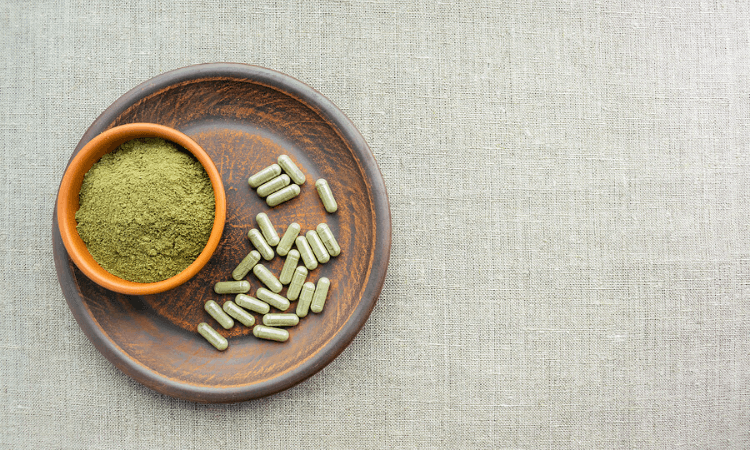
Does Kratom Show up on a Drug Test? – Testing for kratom is uncommon, as the drug’s use is relatively new to the U.S. and is still legal in most states.
The standard 5-panel drug test often used by employers will not detect kratom. These tests only check for the presence of opiates, amphetamines, cocaine, PCP, and marijuana. Some specialized tests can detect kratom, however, but they are unlikely to be conducted in most cases.
| NOTE: It is possible that a test could flag the metabolites of kratom as a different drug. |
How Long Does Kratom Stay in the Body?
Kratom (Mitragyna speciosa) is a tropical tree, the leaves of which have chemical properties that can increase energy levels, relieve pain, or induce relaxation. At lower doses, kratom tends to have stimulating effects, and at higher doses, it is more likely to cause some sedation.
Although kratom is becoming an increasingly popular drug, its effects and elimination times haven’t been the subject of many studies. In-depth research on kratom has been performed on animals but not humans, and hasn’t been conducted since 2015.
The average half-life of kratom is around 24 hours can be as long as 40 hours. For this reason, it’s believed that kratom will be eliminated from a person’s system in 6-9 days.
Determining Factors
Several factors may influence the drug’s duration in the system:
Dosage and Method of Administration
As with most substances, higher doses lead to a longer duration of Kratom effects and detection window. If kratom is orally consumed in a tea or as a pill, it is likely to remain in the body longer than if it is smoked, although the latter method is relatively uncommon.
Type of Leaves
There are a few different strains of kratom leaves. Green leaves are a mild energy booster and have effects that may last for more than eight hours. Red leaves can have either stimulating or sedating effects. White leaves are reported to be highly-stimulating and can enhance a person’s mood for several hours.
Weight and Age
Older users tend to have slower metabolisms than younger people, so they may need more time to process the drug. Also, like marijuana, kratom is fat-soluble, meaning people with a higher amount of body fat may retain traces of kratom for a longer period than those who are leaner.
Diet
Using kratom on an empty stomach could result in a shorter detection window, as opposed to ingesting the drug with a high-fat meal. Also, the more water that is consumed, the more rapidly the body purges itself of traces of mitragynine.

How Is Kratom Metabolized?
The most active alkaloid in kratom is mitragynine. This chemical acts as an opioid agonist, meaning that it activates opioid receptors and, therefore, causes some effects similar to true opiates. This action is why some researchers contend that kratom is actually an opioid, but this contention has been widely debated.
Mitragynine is absorbed through the gastrointestinal tract and reaches peak plasma concentration in under an hour. The liver then metabolizes it and breaks the chemical down into byproducts known as metabolites. Highly acidic environments are likely to destroy these products, so urine pH can also affect elimination times.
Kratom & Drug Testing
Blood tests are uncommon, but may be conducted and can detect kratom during the first 24 hours and for up to several days.
Hair tests are also uncommon for kratom detection, but typically hair follicle analyses have longer detection windows, sometimes up to 90 days.
Urinalysis is the most common method to detect kratom. A urine test can identify the drug’s presence after around six hours, and traces may be detected for up to nine days.
Kratom Abuse and Addiction
As noted, kratom has not yet been the subject of many studies. But, because kratom can induce psychoactive effects, it is generally considered to have the potential for abuse.
Tolerance, a condition in which a person may need to consume increasing amounts to achieve the desired effects, is also possible. This pattern of use can rapidly progress into an addiction.
Kratom has been heralded as a way to address chronic pain or help people detox from the use of opioids by mitigating withdrawal symptoms. This effect occurs because kratom attaches to some of the same receptors in the brain as painkillers. Unfortunately, it’s also been associated with dangerous side effects, abuse, and addiction.
Side effects of kratom may include the following:
- Nausea
- Vomiting
- Itching
- Constipation
- Increased urination
- Rapid heart rate
- Lack of appetite
- Seizures
- Hallucinations
Getting Treatment
If you are abusing kratom, other drugs, or alcohol, help is available! Recovery in Tune offers comprehensive outpatient addiction treatment programs that feature evidence-based services, such as psychotherapy and counseling.
Contact us today if you are ready to break free from the cycle of substance abuse for life!